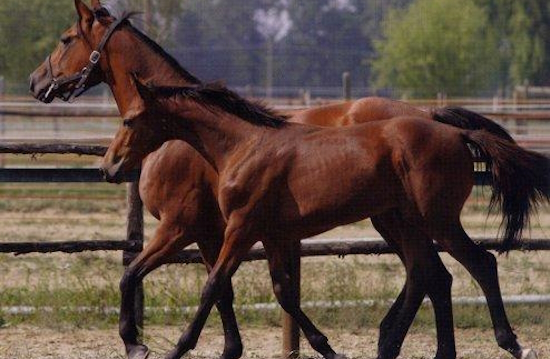GENEALOGICAL BOOKS: Oriental, Anglo-Arabian and Italian Saddle Horse
Horses enrolled in studbooks managed by the MASAF Area Sella, born from typical mares enrolled in studbooks and selected stallions enrolled in studbooks, are constantly monitored by the MASAF, which checks their development and athletic conformation with various tests: first only morphological and then functional, of increasing difficulty.
The MASAF manages and implements the Herd Books Regulations, which represent the instrument for the development and enhancement of the improvement of the registered horses and the direction on a technical level of the selective activity, promoting its economic valorisation. There are three studbooks:
Book I: Oriental Horse;
Book II: Anglo-Arabian Horse:
Book III: Italian Saddle Horse.
Book I groups horses from the areas of origin of the Oriental horse and is divided into two sections:
A) Pure Blood Oriental (p.s.o.) which covers horses descended from the Thoroughbred Arabian or Oriental and their crosses with p.s.a (W.A.H.O.);
B) Oriental, which includes Oriental horses other than Purebred Oriental and Purebred Arabian;
Horses from foreign studbooks recognised by a specific act of the Central Technical Commission are also entered in section B).
For the purpose of calculating the percentage of Arabian blood, Pure Oriental horses (Book I, Section A) are conventionally assigned a percentage of 95% and Oriental horses (Book I, Section B) are conventionally assigned a percentage of 75%.
Book II is for Anglo Arabian horses, also defined according to the International Anglo Arabian Conference (C.I.A.) and is divided into three sections:
A) horses with genotype wholly derived from Purebred English (p.s.i.) and Purebred Arabian (p.s.a.) ancestry meeting WAHO requirements and criteria and their cross-breeds;
B) horses with a genotype deriving at least 15/16 from p.s.i. entered in the relevant studbook and p.s.a. meeting WAHO requirements and criteria and their cross-breeds. The remaining fraction of 1/16 of genotype, i.e. 2/32, must come from ancestors that are not of unknown origin, neither of draught nor pony breeds;
C) other horses that are the offspring of English thoroughbred horses (p.s.i.) entered in the relevant studbook, of Anglo Arabian horses entered in Sections I and II, of Purebred Arabian horses meeting the requirements and criteria established by WAHO crossed with Oriental horses entered in Book I and their crossbreeds.
In the three sections, subjects with less than 25% Arabian blood are defined as "complementary Anglo Arabian" and this condition must be highlighted in all official documents.
In Book II Anglo Arabian Horse, horses from foreign studbooks approved by the C.I.A. are also entered.
Book III Sella Italiano includes:
A) horses born from the crossbreeding between Italian saddle-bred stallions entered in the Main Register and mares of the Maremmana, Salernitana, Persana, Puro Sangue Inglese and Anglo Araba breeds entered in the respective herd books and registry books;
B) horses born from the crossbreeding of Italian Saddle-bred mares entered in the main register or, where applicable, in the supplementary register, with stallions of the Maremmana, Salernitana, Persana and Anglo Araba breeds entered in the respective herd books or registries and that have successfully passed the genetic evaluations provided for in the specifications for in-station genetic evaluation tests of Italian Saddle-bred stallions
C) horses born from the crossbreeding of Italian Saddle-bred mares entered in the main register (or where provided for in the supplementary register) with Pure-bred English stallions entered in the studbook
D) horses born from Italian saddle-bred stallions entered in the main register and saddle-bred mares entered in the main register (or where provided for in the supplementary register).
In Book III of the Italian Saddle Horse, horses from other foreign studbooks are entered within limits set by cross-breeding programmes approved by the Central Technical Commission, and taking into account the selective parameters according to the objectives set.
